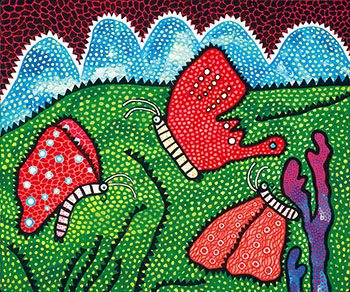Catalogue Note:
Born in a rural area near Matsumoto, Japan in 1929, Yayoi Kusuma suffered from hallucinations as a child; every day was a never-ending struggle with misery and fear. Through constant painting, Kusuma was able to find a release for the unease that plagued her; art provided a means of coping with her mental illness, and gave her a reason to go on living. In 1957, Kusuma traveled to New York (which at that time was home to the most exciting, but also the most competitive, art scene in the world), where she became a leading member of the avant garde. In 1973, Kusuma suddenly abandoned the bright lights of New York to return to Japan, where she voluntarily had herself admitted to a Tokyo mental hospital so that she could concentrate on her artistic creation. “Field End,” which was painted in 1989, is a mature work from the period after Kusuma returned to Japan.
Polka dots filled Kusuma’s mental universe, and through rigorous self-cultivation she succeeded in turning polka dots into a key element in her artistic lexicon, an element that has become synonymous with the name Yayoi Kusuma. In “Field End,” Kusuma uses bright colors and simple shapes to depict the “end” of nature. Red butterflies flit about over green pastures; mountains rise up in the distance. There is no sign whatsoever of human habitation; the picture is covered with dots of various sizes, and a strange red light flickers in the sky. While “Field End” is full of color and a childlike sense of fun, it also embodies a sense of uncertainty and unease. People always tend to focus on butterflies’ beautiful wings, but Yayoi Kusuma has given her butterflies thick, caterpillar-like bodies that are soft and fleshy, revealing the essential nature of butterflies as wild creatures. The dots that fill the canvas cause the scene to “pulsate,” while the saw-tooth edge to the pasture creates a slight sense of pain and anxiety. It is precisely this sense of boundless mystery that gives Yayoi Kusuma’s paintings their immense appeal.
Polka dots filled Kusuma’s mental universe, and through rigorous self-cultivation she succeeded in turning polka dots into a key element in her artistic lexicon, an element that has become synonymous with the name Yayoi Kusuma. In “Field End,” Kusuma uses bright colors and simple shapes to depict the “end” of nature. Red butterflies flit about over green pastures; mountains rise up in the distance. There is no sign whatsoever of human habitation; the picture is covered with dots of various sizes, and a strange red light flickers in the sky. While “Field End” is full of color and a childlike sense of fun, it also embodies a sense of uncertainty and unease. People always tend to focus on butterflies’ beautiful wings, but Yayoi Kusuma has given her butterflies thick, caterpillar-like bodies that are soft and fleshy, revealing the essential nature of butterflies as wild creatures. The dots that fill the canvas cause the scene to “pulsate,” while the saw-tooth edge to the pasture creates a slight sense of pain and anxiety. It is precisely this sense of boundless mystery that gives Yayoi Kusuma’s paintings their immense appeal.
